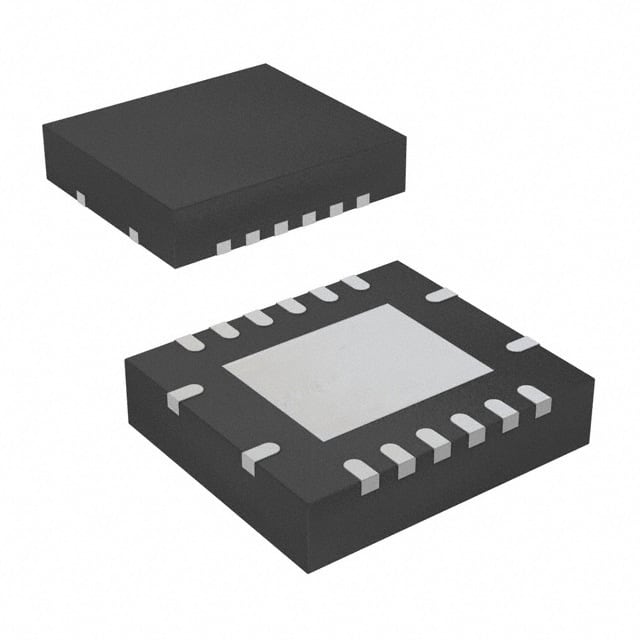Viz Specifikace pro podrobnosti o produktu.

MSP430FR2311IRGYT
Product Overview
- Category: Microcontroller
- Use: Embedded systems, Internet of Things (IoT) devices
- Characteristics: Low power consumption, high performance, integrated peripherals
- Package: 20-pin QFN package
- Essence: MSP430FR2311IRGYT is a microcontroller designed for low-power applications with integrated FRAM (Ferroelectric Random Access Memory) technology.
Specifications
- CPU: 16-bit RISC architecture
- Clock Speed: Up to 16 MHz
- Memory: 4 KB of RAM, 32 KB of FRAM, 256 bytes of information memory
- Peripherals: 10-bit ADC, UART, SPI, I2C, Timer, GPIO
- Operating Voltage: 1.8V - 3.6V
- Temperature Range: -40°C to +85°C
- Power Consumption: Ultra-low power mode with less than 1 µA standby current
Pin Configuration
The MSP430FR2311IRGYT microcontroller has a total of 20 pins. The pin configuration is as follows:
- P1.0 - GPIO
- P1.1 - GPIO
- P1.2 - GPIO
- P1.3 - GPIO
- P1.4 - GPIO
- P1.5 - GPIO
- P1.6 - GPIO
- P1.7 - GPIO
- P2.0 - GPIO
- P2.1 - GPIO
- P2.2 - GPIO
- P2.3 - GPIO
- P2.4 - GPIO
- P2.5 - GPIO
- P2.6 - GPIO
- P2.7 - GPIO
- GND - Ground
- VCC - Power Supply
- RST - Reset
- TEST - Test Mode
Functional Features
- Low power consumption: The MSP430FR2311IRGYT microcontroller is designed for low-power applications, making it suitable for battery-powered devices and energy-efficient systems.
- Integrated FRAM technology: The integrated Ferroelectric Random Access Memory (FRAM) provides non-volatile memory with fast write speeds, high endurance, and low power consumption.
- Rich peripherals: The microcontroller includes various peripherals such as ADC, UART, SPI, I2C, Timer, and GPIO, allowing for versatile connectivity and control options.
Advantages and Disadvantages
Advantages: - Low power consumption enables longer battery life in portable devices. - Integrated FRAM technology offers fast and reliable non-volatile memory. - Rich set of peripherals allows for flexible system design.
Disadvantages: - Limited memory capacity compared to higher-end microcontrollers. - Smaller package size may limit the number of available pins for larger projects.
Working Principles
The MSP430FR2311IRGYT microcontroller operates based on a 16-bit RISC architecture. It executes instructions fetched from its memory and interacts with external components through its integrated peripherals. The low power consumption is achieved by utilizing efficient power management techniques and optimizing the execution of instructions.
Application Field Plans
The MSP430FR2311IRGYT microcontroller finds applications in various fields, including but not limited to: - Internet of Things (IoT) devices - Wearable electronics - Home automation systems - Sensor networks - Industrial control systems
Alternative Models
If the MSP430FR2311IRGYT does not meet specific requirements, alternative microcontrollers with similar features and capabilities include: - MSP430FR2310 - MSP430FR2312 - MSP430FR2313
These alternative models provide options with varying memory capacities, pin configurations, and additional features to suit different project requirements.
In conclusion, the MSP430FR2311IRGYT microcontroller is a versatile and low-power device suitable for various embedded systems and IoT applications. Its integrated FRAM technology, rich set of peripherals, and compact package make it an attractive choice for energy-efficient designs.
Seznam 10 běžných otázek a odpovědí souvisejících s aplikací MSP430FR2311IRGYT v technických řešeních
Sure! Here are 10 common questions and answers related to the application of MSP430FR2311IRGYT in technical solutions:
Q1: What is the MSP430FR2311IRGYT? A1: The MSP430FR2311IRGYT is a microcontroller from Texas Instruments' MSP430 family, specifically designed for low-power applications.
Q2: What are the key features of the MSP430FR2311IRGYT? A2: Some key features include an ultra-low power consumption, integrated FRAM memory, multiple communication interfaces, and a wide range of peripherals.
Q3: What is FRAM memory? A3: FRAM (Ferroelectric Random Access Memory) is a non-volatile memory technology that combines the benefits of both Flash memory and RAM. It offers fast write speeds, high endurance, and low power consumption.
Q4: What are some typical applications of the MSP430FR2311IRGYT? A4: The MSP430FR2311IRGYT is commonly used in applications such as smart meters, sensor nodes, wearable devices, industrial automation, and Internet of Things (IoT) devices.
Q5: How can I program the MSP430FR2311IRGYT? A5: You can program the MSP430FR2311IRGYT using various development tools, such as the Code Composer Studio IDE or Energia, which is an open-source Arduino-like platform.
Q6: What is the power consumption of the MSP430FR2311IRGYT? A6: The MSP430FR2311IRGYT is known for its ultra-low power consumption, with active mode currents as low as 100 µA/MHz and standby mode currents as low as 450 nA.
Q7: Can I interface the MSP430FR2311IRGYT with other devices? A7: Yes, the MSP430FR2311IRGYT offers multiple communication interfaces, including UART, SPI, I2C, and GPIO pins, allowing you to easily interface with other devices or sensors.
Q8: Does the MSP430FR2311IRGYT support analog inputs? A8: Yes, the MSP430FR2311IRGYT has an integrated 10-bit ADC (Analog-to-Digital Converter), which allows you to measure analog signals from external sensors or devices.
Q9: Can I use the MSP430FR2311IRGYT in battery-powered applications? A9: Absolutely! The MSP430FR2311IRGYT's low power consumption makes it ideal for battery-powered applications, as it helps extend the battery life significantly.
Q10: Is there any community support available for the MSP430FR2311IRGYT? A10: Yes, Texas Instruments provides extensive documentation, application notes, and a dedicated online community where you can find resources, ask questions, and get support for the MSP430FR2311IRGYT.
Please note that these answers are general and may vary depending on specific requirements and use cases.

